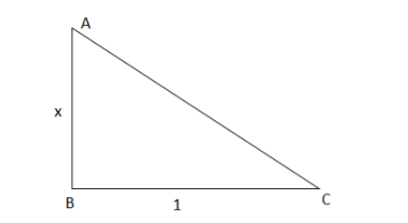
How do you differentiate \[\sec \left( {\arctan (x)} \right)\]?
Answer
540.9k+ views
Hint:Derivatives are defined as the varying rate of a function with respect to an independent variable. We cannot differentiate this directly. First we need to find the value of \[\sec \left( {\arctan (x)} \right)\]. After that we differentiate the obtained answer with respect to ‘x’. we know that \[\tan \theta = \dfrac{{{\text{opposite side}}}}{{{\text{adjacent side}}}}\], \[\sec \theta = \dfrac{{{\text{hypotenuse side}}}}{{{\text{adjacent side}}}}\] and using Pythagoras identity we can find the value of \[\sec \left( {\arctan (x)} \right)\].
Complete step by step solution:
Given, \[\sec \left( {\arctan (x)} \right)\]
Let’s put \[\theta = \arctan (x)\]
Then we have \[\sec \left( \theta \right)\]
Now we took \[\theta = \arctan (x)\],
Then we have \[\tan \theta = x\]
This can be rewrite as
\[\tan \theta = \dfrac{x}{1}\]
We know that \[\tan \theta = \dfrac{{{\text{opposite side}}}}{{{\text{adjacent side}}}}\].
Let’s write a right angle triangle and we need to find hypotenuse side

We need hypotenuse, that is AC.
By Pythagoras identity we have
\[\begin{gathered}
A{C^2} = A{B^2} + B{C^2} \\
A{C^2} = {x^2} + 1 \\
AC = \sqrt {{x^2} + 1} \\
\end{gathered} \]
Thus we have a hypotenuse side.
We know that \[\sec \theta = \dfrac{{{\text{hypotenuse side}}}}{{{\text{adjacent side}}}}\]
\[\sec \theta = \dfrac{{\sqrt {{x^2} + 1} }}{1}\]
That is we have,
\[\sec \left( {\arctan (x)} \right) = \sqrt {{x^2} + 1} \]
Now differentiating with respect to ‘x’
\[\dfrac{d}{{dx}}\sec \left( {\arctan (x)} \right) = \dfrac{d}{{dx}}\sqrt {{x^2} + 1} \]
\[ = \dfrac{d}{{dx}}\sqrt {{x^2} + 1} \]
We know that \[\dfrac{d}{{dx}}(\sqrt x ) = \dfrac{1}{{2\sqrt x }}\dfrac{{dx}}{{dx}}\] and here we assume \[{x^2} + 1\] as one term ‘x’. Then we have
\[ = \dfrac{1}{{2\sqrt {{x^2} + 1} }}\dfrac{d}{{dx}}\left( {{x^2} + 1} \right)\]
\[ = \dfrac{{2x}}{{2\sqrt {{x^2} + 1} }}\]
\[ = \dfrac{x}{{\sqrt {{x^2} + 1} }}\]
Thus the differentiation of \[\sec \left( {\arctan (x)} \right)\] is \[\dfrac{x}{{\sqrt {{x^2} + 1} }}\].
Note: We know the differentiation of \[{x^n}\] with respect to ‘x’ is \[\dfrac{{d({x^n})}}{{dx}} = n.{x^{n - 1}}\]. We also have different rules in the differentiation. Those are
\[ \bullet \]Linear combination rule: The linearity law is very important to emphasize its nature with alternate notation. Symbolically it is specified as \[h'(x) = af'(x) + bg'(x)\]
\[ \bullet \]Product rule: When a derivative of a product of two function is to be found, then we use product rule that is \[\dfrac{{dy}}{{dx}} = u \times \dfrac{{dv}}{{dx}} + v \times
\dfrac{{du}}{{dx}}\].
\[ \bullet \]Chain rule: To find the derivative of composition function or function of a function, we use chain rule. That is \[fog'({x_0}) = [(f'og)({x_0})]g'({x_0})\].
We use these rules depending on the given problem.
Complete step by step solution:
Given, \[\sec \left( {\arctan (x)} \right)\]
Let’s put \[\theta = \arctan (x)\]
Then we have \[\sec \left( \theta \right)\]
Now we took \[\theta = \arctan (x)\],
Then we have \[\tan \theta = x\]
This can be rewrite as
\[\tan \theta = \dfrac{x}{1}\]
We know that \[\tan \theta = \dfrac{{{\text{opposite side}}}}{{{\text{adjacent side}}}}\].
Let’s write a right angle triangle and we need to find hypotenuse side

We need hypotenuse, that is AC.
By Pythagoras identity we have
\[\begin{gathered}
A{C^2} = A{B^2} + B{C^2} \\
A{C^2} = {x^2} + 1 \\
AC = \sqrt {{x^2} + 1} \\
\end{gathered} \]
Thus we have a hypotenuse side.
We know that \[\sec \theta = \dfrac{{{\text{hypotenuse side}}}}{{{\text{adjacent side}}}}\]
\[\sec \theta = \dfrac{{\sqrt {{x^2} + 1} }}{1}\]
That is we have,
\[\sec \left( {\arctan (x)} \right) = \sqrt {{x^2} + 1} \]
Now differentiating with respect to ‘x’
\[\dfrac{d}{{dx}}\sec \left( {\arctan (x)} \right) = \dfrac{d}{{dx}}\sqrt {{x^2} + 1} \]
\[ = \dfrac{d}{{dx}}\sqrt {{x^2} + 1} \]
We know that \[\dfrac{d}{{dx}}(\sqrt x ) = \dfrac{1}{{2\sqrt x }}\dfrac{{dx}}{{dx}}\] and here we assume \[{x^2} + 1\] as one term ‘x’. Then we have
\[ = \dfrac{1}{{2\sqrt {{x^2} + 1} }}\dfrac{d}{{dx}}\left( {{x^2} + 1} \right)\]
\[ = \dfrac{{2x}}{{2\sqrt {{x^2} + 1} }}\]
\[ = \dfrac{x}{{\sqrt {{x^2} + 1} }}\]
Thus the differentiation of \[\sec \left( {\arctan (x)} \right)\] is \[\dfrac{x}{{\sqrt {{x^2} + 1} }}\].
Note: We know the differentiation of \[{x^n}\] with respect to ‘x’ is \[\dfrac{{d({x^n})}}{{dx}} = n.{x^{n - 1}}\]. We also have different rules in the differentiation. Those are
\[ \bullet \]Linear combination rule: The linearity law is very important to emphasize its nature with alternate notation. Symbolically it is specified as \[h'(x) = af'(x) + bg'(x)\]
\[ \bullet \]Product rule: When a derivative of a product of two function is to be found, then we use product rule that is \[\dfrac{{dy}}{{dx}} = u \times \dfrac{{dv}}{{dx}} + v \times
\dfrac{{du}}{{dx}}\].
\[ \bullet \]Chain rule: To find the derivative of composition function or function of a function, we use chain rule. That is \[fog'({x_0}) = [(f'og)({x_0})]g'({x_0})\].
We use these rules depending on the given problem.
Recently Updated Pages
Master Class 11 Economics: Engaging Questions & Answers for Success

Master Class 11 English: Engaging Questions & Answers for Success

Master Class 11 Social Science: Engaging Questions & Answers for Success

Master Class 11 Biology: Engaging Questions & Answers for Success

Class 11 Question and Answer - Your Ultimate Solutions Guide

Master Class 11 Business Studies: Engaging Questions & Answers for Success

Trending doubts
What is meant by exothermic and endothermic reactions class 11 chemistry CBSE

10 examples of friction in our daily life

One Metric ton is equal to kg A 10000 B 1000 C 100 class 11 physics CBSE

Difference Between Prokaryotic Cells and Eukaryotic Cells

What are Quantum numbers Explain the quantum number class 11 chemistry CBSE

1 Quintal is equal to a 110 kg b 10 kg c 100kg d 1000 class 11 physics CBSE




